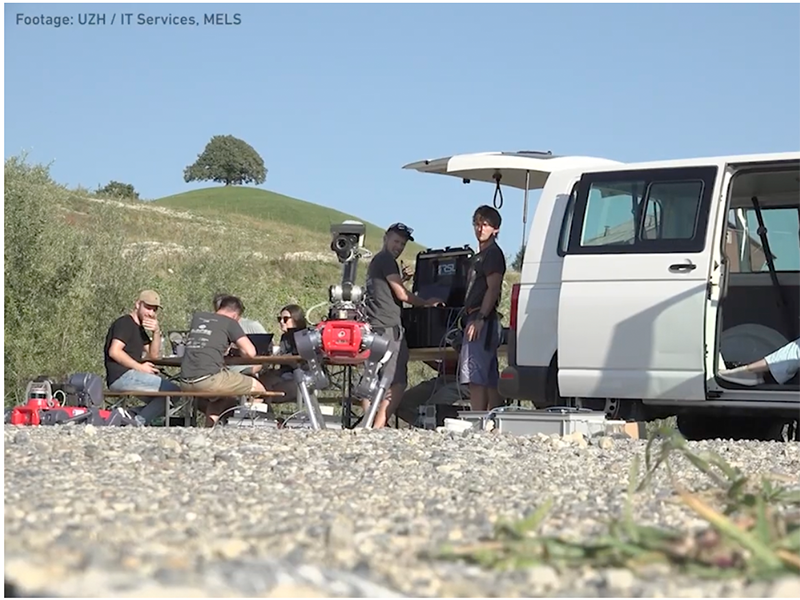Lunar missions
Robot Team to Explore the Moon
Swiss researchers are equipping legged robots with scientific instruments to search for minerals and resources on the Moon. One major strength of these robots is their ability to work as a team: even if one robot fails, the mission continues.
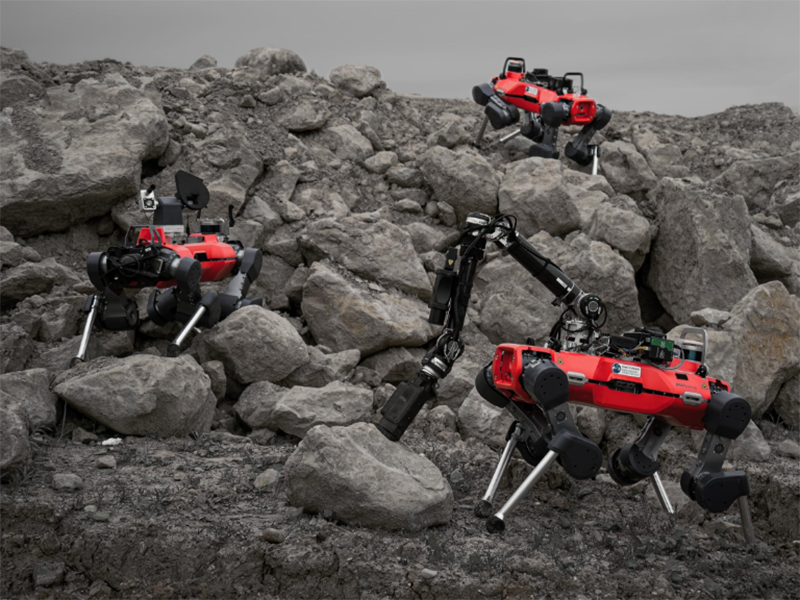
On the Moon, there are raw materials that humanity could one day mine and use. For this reason, various space agencies, such as the European Space Agency (ESA), are planning missions to Earth’s satellite. This calls for appropriate exploration vehicles. Led by ETH Zurich, Swiss researchers are pursuing the idea of sending not just one solitary rover, but rather an entire team of vehicles that complement each other. Valentin Bickel, from the Center for Space and Habitability (CSH) at the University of Bern, is a planetary scientist and a member of this research team. Bickel is also a member of the National Centre of Competence in Research (NCCR) PlanetS.
Triumph at the Space Resources Challenge
For this, the researchers equipped three Anymal legged robots, which have been developed at ETH Zurich, with a variety of scientific instruments. They tested the robots on various terrains in Switzerland before participating with the robot team in the ESA Space Resources Challenge, a European competition for Moon rovers, organized by the European Space Innovation Center (ESRIC) in Luxembourg.
"The competition required the participating robots to find and classify specific minerals in an area that closely resembled the lunar surface," explains Valentin Bickel. Participation in the competition was extremely successful - the researchers from the Universities of Bern and Basel, ETH Zurich, and the University of Zurich, along with other colleagues from the FZI Research Center for Information Technology in Karlsruhe, won the challenge. The extensive, multi-institutional collaboration was carefully orchestrated: "I have been working with the Robotic Systems Lab at ETH in previous projects. We invited additional members to close specific knowledge gaps in the team," says Bickel. "Our success in the challenge is a great validation of our approach to deploy not just one single robot, but a group of robots that back each other up."
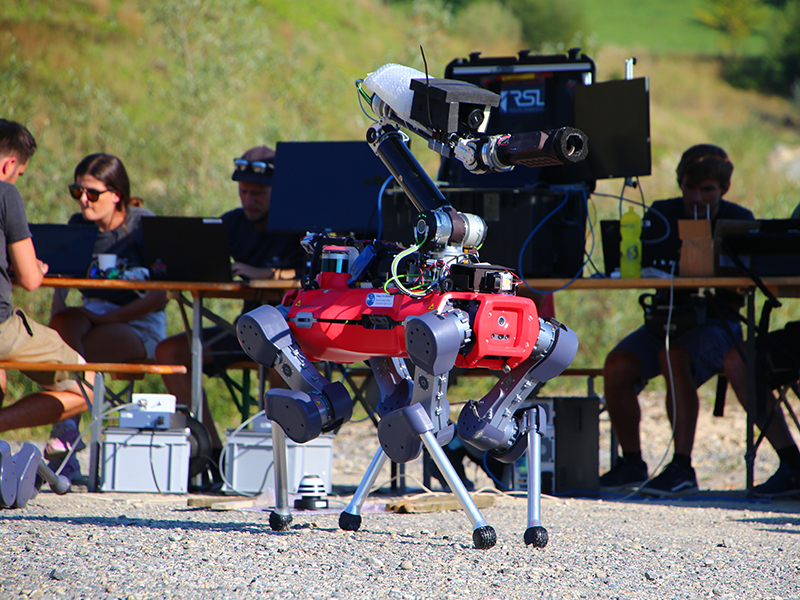
Teamwork on the Moon: Specialists and Generalists
In the latest issue of the journal Science Robotics, the researchers describe how they go about exploring unknown terrain using a team of robots. "Using multiple robots has two advantages," explains Philip Arm, a doctoral student at the Department of Mechanical and Process Engineering at ETH Zurich and the lead author of the study. "The individual robots can tackle specialized tasks and perform them simultaneously. Moreover, thanks to its redundancy, a robot team is able to compensate for a teammate’s failure." Redundancy in this case means that important instrumentation is installed on several robots. In other words, redundancy and specialization are opposing traits. “Getting the benefits of both is a matter of finding the right balance,” Arm says.
The researchers solved this problem by equipping two of the legged robots as so-called specialists. One robot is programmed to be particularly good at mapping the terrain and classifying its geology. It uses a laser scanner and several cameras – some of them capable of spectral analyses – to gather initial clues about the mineralogic composition of the terrain. The other specialist robot is capable of precisely identifying rocks using a Raman spectrometer and a microscopic, multi-spectral camera. "I was involved in the development of some of the instrumentation as well as the software and algorithms used for data analysis," says Valentin Bickel.
The third robot is a generalist: it can both map the terrain and characterize rocks, which means it can cover a broader range of tasks than the specialists. However, its less specialized instrumentation enables it to perform these tasks with less precision. "The redundancy within the robot team makes it possible to complete the mission should any one of the robots malfunction," Arm says.
Increasing Autonomy and Combined Modes of Transportation
At the Space Resources Challenge the jury was particularly impressed by the redundancy the researchers integrated into their exploration system to make it resilient to potential failures. By winning the challenge, the Swiss researchers, along with the colleagues from the FZI Research Center for Information Technology in Karlsruhe, were awarded a one-year research contract worth a total of 500,000 Euros to further develop this technology.
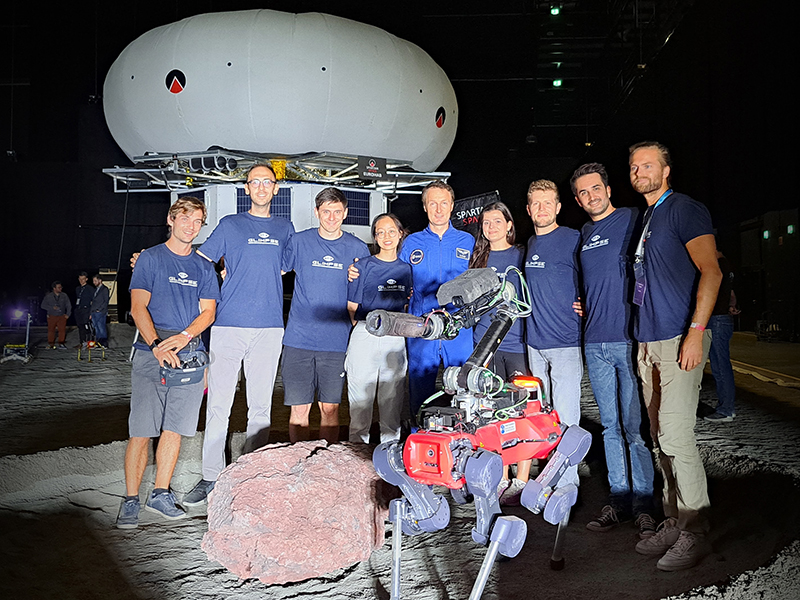
In this process, not only legged robots will be used, but also robots with wheels. Legged robots remain very mobile in rocky and steep terrain, for example when it comes to descending into a crater. In turn, robots with wheels can move faster on more benign terrain. For a future mission, it would therefore make sense to combine robots that differ in terms of their mode of locomotion.
Furthermore, the researchers also plan to make the robots more autonomous. At present, all data generated by the robots is down-linked into a control center, where an operator assigns tasks to individual robots. In the future, semi-autonomous robots could directly assign certain tasks to each other, with control and intervention options for the operator. One thing is for sure, the researchers will not get bored: "Interdisciplinary communication and the technical implementation of scientific requirements are among the biggest challenges for me. The journey from 'I would like to have this specific image product' to the design and integration of the required hardware and software in the network of robots is long!" says Bickel.
This article is based on an article from ETH Zurich: More information
REFERENCE
Arm P, Waibel G, Preisig J, Tuna T, Zhou R, Bickel V, Ligeza G, Miki T, Kehl F, Kolvenbach H, Hutter M: Scientific Exploration of Challenging Planetary Analog Environments with a Team of Legged Robots. Science Robotics, 12. Juni 2023, doi: 10.1126/scirobotics.ade9548
About the person
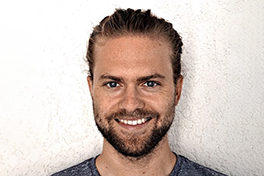
Valentin Bickel
is a Fellow at the Center for Space and Habitability (CSH) at the University of Bern and a member of the National Centre of Competence in Research (NCCR) PlanetS. He earned his doctorate at ETH Zurich and the Max Planck Institute for Solar System Research, conducting several research stays at institutes in the USA, such as the NASA Jet Propulsion Laboratory. Valentin Bickel uses a combination of traditional engineering-geological methods, orbital and robotic remote sensing, and machine learning to investigate dynamic processes on the surfaces of the Moon, Mars, and Mercury.
Contact:
Dr. Valentin Bickel: valentin.bickel@unibe.ch
About the Center for Space and Habitability (CSH)
The mission of the Center for Space and Habitability (CSH) is to foster dialogue and interactions between the various scientific disciplines interested in the formation, detection and characterization of other worlds within and beyond the Solar System, the search for life elsewhere in the Universe, and its implications for disciplines outside of the sciences. The members, affiliates and collaborators include astronomers, astrophysicists and astrochemists, atmospheric, climate and planetary scientists, geologists and geophysicists, biochemists and philosophers. The CSH is home to the CSH and Bernoulli Fellowships, which host young, dynamic and talented researchers from all over the world to conduct independent research. It actively run a series of programs to stimulate interdisciplinary research within the University of Bern including collaborations and/or open dialogue with Medicine, Philosophy and Theology. The CSH has an active tie to the Centre for Exoplanets & Habitability of the University of Warwick. It is active in implementing gender equality measures and public outreach.
